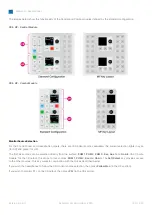
diamond - User Manual
Version: 8.0.0/1
Exported on: 24 October, 2023
139
/
228
•
•
To open the dialog box, press an
Access
key (on the fader strip) followed by a page option (on the GUI) - e.g.
Dynamics
.
Peak Metering
In the standard configuration, all of the peak meters are dynamic Peak Program Meters (PPMs). The number of individual
bargraphs is defined automatically by the format of the source/bus: 1 for mono; 2 for stereo.
The meters use a digital scale relative to 0dBFS, and provide three color-coded areas: green, orange and red. When signals
peak within the orange area, they are at a good operating level. If a meter turns red, then the signal level is overloading.
Loudness Metering
The system provides loudness metering conforming to the ITU-R BS1770. There are two types of measurement: momentary
and integrated.
In the standard configuration, both measurements are shown for all outputs, while momentary loudness can be enabled or
disabled for all sources.
Momentary Loudness (Bargraphs)
A single blue bargraph represents the average energy of the summed component channels: mono, stereo or surround. The
average is measured using either a Momentary (400ms sliding window) or Short term (3s sliding window) integration time.
The color indicates whether loudness is above or below the Target Level:
Light Blue = equal to, or below, the Target Level.
Dark Blue = above the Target Level.
The scale markers indicate a tolerance of +/- 1 LU.
Integrated Loudness Measurement (Text Readout)
The integrated loudness measurement is very useful for measuring loudness over a longer period.
The measurement is displayed in LUFS (Loudness Units Full Scale).
















































